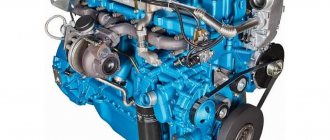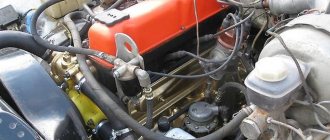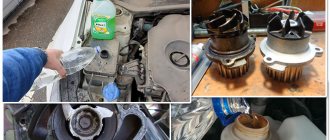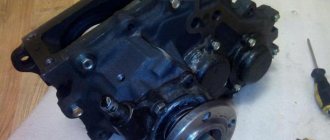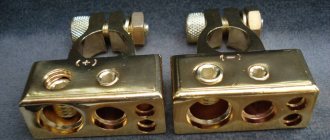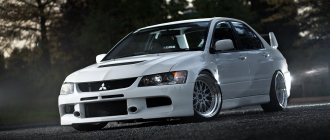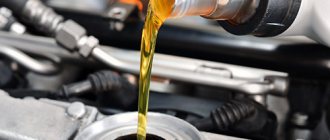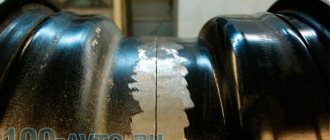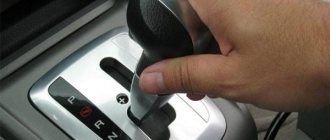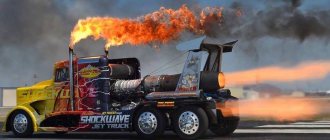17.02.2020
| (Votes: 1, Rating: 5) |
Issues discussed in the material:
- What is the difference between AT and MT tires?
- How AT and MT tires are studded
- What to consider when choosing wheels for AT and MT tires
- The best AT tire models
- The best MT tires
- Reviews from car owners about AT and MT tires
AT and MT tires belong to the category of rubber that SUV owners most often pay attention to. It's no secret that outside of asphalt, a lot depends on the size and, most importantly, the type of tire. Even the most powerful and equipped jeep will not go far without the right wheels.
But here another problem immediately arises - which of these types of tires to choose? As always, most people want versatility: to be comfortable on the track and confident in the dirt. But is this possible? In our article we will understand the difference between AT and MT tires, and also talk about the features of their operation.
AT and MT tires - what is the difference
To determine the main difference between AT and MT tires, we will consider each type of tire separately.
AT tires
AT (All Terrain) is a tire that maximally satisfies the criterion of versatility. It can be used for driving on asphalt and off-road with a low level of difficulty. AT tires have a reinforced sidewall and an aggressive tread pattern. They are designed for driving on asphalt, sand, dirt and stone roads.
Separately, it is worth considering the tread of such rubber. It, unlike the tread of road tires, has a fairly deep and aggressive pattern. At the same time, you can even find small lugs in the shoulder area. But the distance between the elements of the pattern will not be as large as that of real off-road tires. This particular tread is considered classic for universal rubber.
The composition used to produce AT tires, presented in the middle and minimum price categories, is such that the rubber “tanks” in the cold, and this negatively affects road grip. As a result, the SUV will lose control, even despite all-wheel drive and modern electronic systems. This feature is typical for many tires of this type, with the possible exception of well-known brands such as ProComp or Mickey Thompson.
The composition of the raw materials used for the production of tires has a significant impact on the performance characteristics of wheel tires. For example, Cooper Discoverer M+S tires, which are designed for winter, even with a universal tread pattern (typical of AT tires), are far superior in handling to most AT tire models.
Why do AT tires become less efficient in winter? This is due to the loss of elasticity in the cold and the characteristics of the tread pattern, which slows down the process of self-cleaning of tires.
On hard road surfaces, AT type tires have proven themselves quite well. Such tires are not very effective at high speeds, but SUVs are also designed for completely different driving conditions. If you drive no faster than 140 km/h, then AT tires provide good car handling (our highways are not suitable for higher speed driving).
It is worth considering a number of features of tires of this type:
- the braking distance of AT tires is longer than that of road tires;
- AT rubber is stiffer;
- the universal tread pattern of AT tires promotes aquaplaning;
- AT asphalt tires are noisy;
- AT tires have increased rolling resistance, which increases fuel consumption.
In conditions where there is no hard road surface, AT tires are significantly inferior to MT tires. We are not talking about the roads that a Porsche Cayenne can overcome, but about off-road conditions that UAZs and Land Rover Defenders can handle.
The disadvantages of AT tires are due to the fact that their tread becomes clogged with mud or snow and does not clean itself well. Low self-cleaning ability is typical for all tires with a very deep tread and a small distance between the tread elements. Such tires pick up a lot of dirt, which is retained when the wheel rotates at low speed. The clogged pattern makes the tire slick, making it difficult for it to grip the road to ensure controlled vehicle movement.
On rocky surfaces or dry loose soil, AT rubber behaves quite effectively, because in this case the tread does not clog, but as soon as the wheels hit wet clay or wet snow, all-purpose tires become “helpless.” To ensure that the SUV does not lose control on a difficult road, it is necessary to ensure that the wheel tread is quickly cleared of dirt. This requires a certain rotation speed, that is, the car must overcome obstacles faster or actively slip (in the latter case, the SUV will most likely lose speed and dig in).
On quicksand, clay or black soil, AT tires cannot truly bite into the road surface and push the SUV in the direction of travel. Once the tread pattern becomes clogged, the car will inevitably become stuck.
We recommend
“Pirelli Cinturato tires – why are reviews about them always positive?”
More details MT tires
The very marking of AT and MT tires suggests which tire is best to use for off-road use. The MT (Mud Terrain) symbols indicate that the tires are designed for driving on poor roads. The word Mud in English means "dirt". MT tires have a “tractor” tread. They have strong side lugs and the pattern is less prone to holding dirt. Unlike AT rubber, MT tires will be more “oaky”. They are less comfortable on paved surfaces and not as effective on ice. MT tires are designed for driving on deep ruts, clay, mud and swampy roads.
The fact that this type of tire does not provide the necessary controllability of the car in winter is, again, due to its composition. It hardens and its characteristics resemble plastic, sliding on ice and compacted snow. On virgin snow, if you lower the MT tires, the car’s handling will still be tolerable, but if you go out on a winter road, it will be very difficult to move. Manufacturers of this type of rubber, as a rule, do not say that it can be used in winter. Most often these are summer tires. Car owners can be confused by the holes for the studs (for example, in the Hankook Dynapro MT (RT03)) and the M+S marking. This is nothing more than a marketing ploy. For the winter, it is worth installing special tires with a characteristic pattern, which are made of a compound that retains elasticity in the cold.
MT type tires are not intended for high-speed driving on asphalt roads. Here they behave even worse than AT tires. A deep “tractor” tread with a large distance between the pattern elements contributes to high-quality off-road traction, but has a negative impact on speed characteristics. Due to the strongly marked “checkered” patterns, the contact patch with the hard road surface of MT tires is smaller than that of AT tires, therefore the braking distance is longer, which is especially noticeable during rain. The high profile behaves well on a difficult track, but “breaks” on the asphalt, so the car’s handling when cornering is significantly reduced.
The “tractor” pattern makes a lot of noise when driving on an asphalt road. The “toothed” tread has increased rolling friction, which increases fuel consumption. MT tires are stiffer, which affects the ride comfort on highways. In addition, they wear out faster on hard surfaces. Most MT tire models have a speed limit of 120 km/h or 140 km/h. There are also tires of this type, which indicate a limit of 160 km/h, but at high speed a car on such tires turns into a projectile, quickly flying towards the target. Driving the car will be uncomfortable and dangerous.
Off-road is the element of MT tires. If you test drive identical cars equipped with AT and MT tires on a difficult road, the difference will be noticeable. Here it becomes clear that you should start tuning an SUV by selecting the right wheels. Areas where the driver of a car on AT tires will feel complete hopelessness, a car equipped with MT tires will pass without any particular difficulties.
Tires with a sparse pattern will work in clay slurry like the paddle wheel of a steamship. The car will continue to move until it hits a bump. This tread easily cleans itself of accumulated dirt, and the wheels cling well to the road.
Super Swamper TSL Bogger tires, which are classified as extreme tires, have this tread. But on asphalt these tires wear out very quickly. They are too stiff and lose control at high speed.
By reducing the pressure in MT tires, you can significantly increase the vehicle's cross-country ability. But in this case, you need to follow some rules for driving the car. If you maneuver quickly and press the gas pedal hard, the wheels can come off. You need to press the accelerator smoothly. On soft ground, tires with a high tractor tread can quickly dig in, and the entire bottom of the car will lie on the mud.
We recommend
“Secrets on wheels: selection criteria and operating secrets” More details
If your car drives only on asphalt surfaces and occasionally drives onto not very rough dirt roads, then you can buy AT tires for its wheels. Motorists who often go fishing and drive a lot off-road should pay attention to MT tires. If you have the financial means, you can buy a spare set of MT tires, which will be installed on the wheels before traveling on difficult roads, and the rest of the time you should use AT tires. If at any time you can take a new route with a bad road, then use MT tires as a permanent set.
Features of choice
If the list of “cons” does not put you off, and the desire to purchase a car equipped with an AMT has been consciously formed, it makes sense to collect as much data as possible about the AMT of a specific car model. Each model is characterized by its own behavioral characteristics. For example, some boxes are characterized by a special “lag”: gears are switched with a delay of up to 2 seconds.
Cars equipped with AMT have appeared on our roads relatively recently. Meanwhile, this type of gearbox has enough advantages to make the robotic gearbox one of the most sought after and valued by car enthusiasts.
Video about what AMT is using the Lada Xray as an example:
Studring of AT and MT tires
The best option for winter driving in our climatic conditions is tires with studs for SUVs. The design of the studs is matched to the tire tread. AT rubber has a pattern that is not that deep. It has frequent lamellas, so studs with small sizes are better suited for such tires. Most often, universal designs are used, which are adapted for passenger cars and trucks. Their standard sizes are: 8-11-2TS, 8-11-3, 8-12-2TS, 8-13-2TS or 8-14-2TS (larger than for passenger cars and able to withstand increased loads). Such studs protrude only slightly from the tread, so they do not greatly increase the braking distance on asphalt surfaces. These models are well suited for mixed driving (in the city and outside the city).
The tenon markings indicate the maximum flange diameter, overall length (second pair of numbers) and number of flanges (last number). Using the letter index, you can determine the structural characteristics of the spike.
As noted earlier, MT tires have a deeper tread with larger tread blocks. To drive on bad roads, jeeps are often subject to additional preparation. Car owners equip them with winches, snorkels, powerful luggage racks, additional tanks, towing eyes, and also strengthen the body frame. All attachments significantly increase the weight of the SUV. To stud heavy SUV tires, truck studs 11-15-2, 11-17-2, 12-15-3 or 12-17-3 with a solid insert that can withstand high loads and a massive body are used. All-season Mud Terrain tires with studs are an excellent solution for driving on rough roads.
Studding of AT and MT tires is carried out using different technologies using different tools, but such processes also have a couple of common stages:
- It is necessary to draw up a studning scheme in such a way that in the contact patch each stud moves along a separate running track.
- Then you should select the size of the studs, taking into account the weight of the car, tire model, possible loads and driving conditions.
Further steps for studding AT and MT tires will be different.
Purpose and transmission diagrams
The direct purpose of the car transmission is to step by step regulate the torque from the flywheel and distribute it over the drive wheels.
MTs make it possible to coordinate the operation of the internal combustion engine with the resistance to vehicle movement, expanding the traction force on the drive wheels and the range of speed changes.
The transmission scheme of a car depends on whether the car in front of us is front-wheel drive or rear-wheel drive.
In a vehicle with rear wheel drive, the transmission most often includes a clutch,
gearbox
, cardan mechanism, rear drive axle assembly. This option is very popular with commercial vehicles (including trucks, buses).
In vehicles with front-wheel drive (the most common option for passenger cars), the transmission most often includes: clutch, transaxle, cardan drive to the front drive wheels and constant velocity joints.
The clarification “most often” when describing the design was made for the reason that some elements can “migrate”. For example, transaxle can be found in the design of some cars with rear-wheel drive. This design solution was used more than once in the production of some Chevrolet and Nissan Alfa Romeo models. The solution is especially popular with sports cars with independent suspension. Transexl can be connected to the internal combustion engine using various shafts (cardan shafts, with rubber couplings).
The transmission design of all manual all-wheel drive vehicles and a number of vehicles with additional equipment (for example, municipal vehicles) also includes a transfer case.
Separately, it is worth paying attention to the hydromechanical schemes. They do not have a clutch, but each gearbox stage is equipped with an autonomous shift element.
AT tire stud technology
This operation will be easier if the tires are removed from the rims. AT tires are studded in the following sequence:
- First of all, you should prepare the mounting locations for the spikes. Here you will need a drilling machine PSSh-3-15, which allows you to cut holes of the required depth using a tube with thin walls.
- The resulting holes are blown with air under pressure. Then, with the help of semi-automatic studs from OKU GmbH (Germany), the studs themselves are installed. Semi-automatic equipment from OKU GmbH is designed to work with spikes with a flange diameter of 8–9 mm.
MT tire stud technology
Here the procedure will be slightly different. It includes the following steps:
- Places for tenons need to be arranged using a drill equipped with a special tubular drill.
- The prepared areas should be blown with compressed air and lubricated with a special composition of the FinTippa trademark, which simplifies the installation of the tenons.
- Let's move on to installing the spikes. For this procedure, you will need EP-12 pneumatic pistols from the German company OKU GmbH, designed for spikes with a flange diameter of 11–12 mm. Installation is carried out under a pressure of 10 atm.
With the help of studded tires for SUVs, you can more effectively use all the advantages of tires for winter driving.
Rules for selecting wheels for AT and MT tires
If you want to install mud tires on an SUV, you should first buy rims for custom-sized wheels (a common practice for buying large wheels for driving in mud). Don’t forget to pay attention to the basic parameters of the disks: what they are made of, what their width and diameter are, and their offset.
Auto store specialists will help you choose models that suit your car. There are light alloy, stamped (iron) and forged wheels. Let's figure out what their main differences are.
Stamped discs
Durable rims that drivers need more for off-road racing and competition. Features of iron discs:
- Why were they given this name? Because the existing stamping is very strong, which is extremely important for racing. If a tire accidentally breaks while driving, don’t worry, because stamped wheels are so strong that they don’t even deform. They can always be straightened if necessary.
- An additional advantage is that the wheel coatings will not be damaged, the paint will remain intact when using hi-jack and lift-mate. If you see rims with beadlocks, you can be almost 100% sure that these are stamped rims.
We have appreciated the advantages of stamped discs, but what about the disadvantages?
- Increased risk of metal corrosion compared to other types of discs.
- Almost 2 times heavier than other types.
- The price is quite high (the cost of stamped ones is slightly different from light alloy ones).
We recommend this type of disc to those car owners who often drive through rural areas and dirt roads. You can always quickly correct the deformation without resorting to the help of specialists.
We recommend
“How to choose a wheel rim: 9 main parameters” Read more
Alloy wheels
Aluminum alloy allows alloy wheels to be significantly lighter than their previous (forged) counterparts. Also, their appearance is more modern and stylish, which is important for many car enthusiasts. Unfortunately, the hardness of aluminum plays a negative role here: with a strong impact, the disk is more likely to break rather than bend. We strongly recommend choosing alloy wheels only for driving on good roads, as if a wheel breaks, you will not be able to repair it without assistance.
Forged wheels
Forged wheels combine lightness and strength, and are also made of aluminum, like the previous type. However, for warforged, a different technology is used. The advantages of these discs are significant: due to their light weight, the car's handling and maneuverability levels increase. Fuel consumption is lower. Car enthusiasts will also appreciate that forged wheels are durable - bumpy roads are no longer an issue.
However, there are several disadvantages:
- high fees for such benefits;
- low level of convenience (such an unpleasant surprise is associated with the high strength of the wheels: in this case, we recommend installing high-profile tires).
Disc diameter and width
There is a direct relationship between wheel size and tire size: wide disk – wide tires. For SUV wheels, the width of the rims should be 75% of the tire width. For example, the rim width is 8, then the tire should be 12.5.
Why exactly this proportion?
- Before participating in races and other off-road events where you have to drive a car on sandy surfaces and swampy areas, reduce tire pressure. A narrow disk presses with much greater force than a wide one. In this case, the tire remains in place if the pressure is reduced. In reality, these parameters are determined by the characteristics of the tire and wheels, correct installation and driver experience. Beadlocks are also installed to prevent dismantling.
- When it comes to tires, they are usually slightly wider than the tread (the contact part). To reduce the protrusion of the side parts, install wider tires. This way the lugs on the sides will be more “toothy”. The cross section of the wheel must be reduced, then the resistance to the amount of dirt and other liquid when the car wheels are in operation is reduced. It is worth remembering: if wide rims are installed, there will be more tire contact. This parameter is taken into account when driving on soft surfaces or swamps.
Disc offset
First, let's look at what disk ejection is. Disc offset is the distance (in millimeters) between the plane of the wheel and the application of the disc to the hub. For wide tires, select a wheel with a large offset. This is done so that the large wheel does not touch the parts and body of the car. Don't forget: the longer the offset, the higher the pressure on the bearings. So choose wheels that do not deviate from the standard ones.
To choose the right offset for your car, you should try on wheels of different sizes on already installed tires. Then you can find the perfect flight. For UAZ and many modifications of Nissan or Toyota, for tires 33–36 x 12–13” x 15, an offset of 19 ml is suitable if the tire costs 33–36 x 12–13” x 15. For Niva with wheels 215/ 75/15, 235/75/15 or 30–31 x 9.5 x 15 +28 offset required.
It is impossible to determine the size of discs with offset by eye; it is necessary to take into account the conditions in which the machine was operated. The choice of wheels also depends on the type of suspension and installed tires.
Detailed description of the study
Thyroid peroxidase is a glycoprotein enzyme found in the epithelial cells of the thyroid follicles. It carries out the oxidation of iodides to “active” iodine and iodination of tyrosine, subsequently the precursors of thyroid hormones are formed (T4 predominates). Determination of the level of autoantibodies to thyroid peroxidase is used as a marker of autoimmune diseases of the thyroid gland, as an indicator of the risk of developing postpartum thyroiditis. Thyroid function decreases mainly due to decreased T4 secretion.
Antibodies to thyroid peroxidase are specific immunoglobulins directed against the enzyme contained in the cells of the thyroid gland and responsible for the formation of the active form of iodine for the synthesis of thyroid hormones. They are a specific marker of autoimmune thyroid diseases. The thyroid enzyme thyroid peroxidase plays a key role in the formation of thyroid hormones. Thyroid peroxidase is involved in the formation of the active form of iodine, without which the biochemical synthesis of thyroid hormones T4 and T3 is impossible. The appearance of antibodies to this enzyme in the blood disrupts its normal function, resulting in a decrease in the production of the corresponding hormones. Hypothyroidism manifests itself in the form of symptoms such as weight gain, goiter, dry skin, hair loss, constipation, and increased sensitivity to cold. Hyperthyroidism is accompanied by sweating, rapid heartbeat, anxiety, tremors in the limbs, weakness, sleep disturbances, weight loss, and exophthalmos. Thyroid peroxidase antibodies are the most sensitive test for detecting autoimmune thyroid disease. Usually their appearance is the first shift that is observed in the course of developing hypothyroidism due to Hashimoto's thyroiditis. Detection of AT-TPO during pregnancy indicates the risk of developing postpartum thyroiditis in the mother and a possible impact on the development of the child.
The best AT tire models
- BF Goodrich All-Terrain KO2. An interesting option, it has an unusual tire size 215/70 R16. The diameter in fact is slightly more than 700 mm, which is not so common. However, this dimension is perfect for cars of the Hyundai Tucson class, for example. Russian car brands can also use BF Goodrich All-Terrain KO2 for Niva, even without a lift. Thanks to three layers of special fiber, the tires turned out to be light (no more than 15 kg), capable of changing shape at reduced pressure. The disadvantages of this model are still insufficient strength, but the manufacturing company assures its customers of a new system used to improve the tires. A solution to this problem was found: the tire walls were increased by almost 5 mm, the rubber composition was changed, and the level of abrasion was reduced. This model from Michelin is suitable for lovers of fast driving and extreme sports. In wild areas with bad roads, tires perform well at both pressures of 0.5 atm and 2 atm. With careful use, you can drive for up to three seasons, but remember that the tires wear out quickly on sharp turns and bends. Can be easily cleaned with gas. The price (together with quality) is about 10,000 rubles.
- Bridgestone Dueler AT 001. Let's move on to another model, this time Japanese. Initially, two AT tires of the same name were released, replacing the 697 model. But we will analyze the Bridgestone Dueler AT 001. The manufacturer confidently stated that these tires have become quieter and the car has become much better to drive. If you look closely at all the strange patterns on the tires, it’s hard to believe that the cross-country ability has remained the same. However, the Japanese have seriously worked on the lateral areas and shoulders, so sharp bends and turns can be made to the maximum. Coasting traffic increased by almost 20%. If we talk about weight, the Dueler AT 001 are not the heaviest (almost 15 kg), the tire size is the same as the above-mentioned BF Goodrich-215/70 R16, but the diameter is larger (884 mm). The model can be used in the winter season. Price – within 6,500 rubles.
- Continental Crosscontact ATR. A quality product that can be used both on asphalt and off-road. However, the best qualities of the Crosscontact ATR, such as handling ability and noise reduction, appear more on off-roads. Manufacturers wanted to achieve exactly this effect. The idea was brought to life through a special pattern on the sidewalls. Small checkers quickly clean tires on difficult surfaces. Many rubbers suffer from contamination, so this function is a real godsend for those who like to drive through swamps. Another advantage is that usually the tire pressure is reduced several times; in this case, nothing like that needs to be done. If you look at customer reviews of the Continental Crosscontact ATR, they note other advantages of the model: rigidity, stability. Tire size – 215/65 R16, weight – about 15 kg. The diameter is smaller than previous models (684 mm). Almost 10 mm – tread depth. A little more expensive than the Japanese friend, the price is a little more than 7,000 rubles.
The best MT tires
- BFGoodrich Mud-Terrain KM3. KM3 is the third generation of MT tires. Rubber contains mixtures and substances that are used for racing cars. The pattern on the sidewalls remained the same as the previous model, but the checkered patterns were modified. The pattern is positioned in such a way that the surface grip is always maximum. An important change in the third generation model was the shoulders and sides. Now the tread is also located on the side, which makes driving on unpaved surfaces more stable, even if the tire pressure is reduced. The sidewall has become a quarter stronger than in KM2. Available in 24 sizes. Get ready to pay at least 13,000 rubles for a tire. However, when compared with the previous model, there is practically no difference. There the price starts at 14,000 rubles, so new tires are worth it.
- Comforser CF3000 120/116Q . Made in China, tires have long become popular outside this country and Asia. The main disadvantage is only instability during balancing. For a 788mm wheel, almost 300g of weights are required. Can be used under tension and is easy to bury. It doesn't take much effort to get out of a rut. The Chinese assure their customers that tires can be used even at -30 °C. The fact is that natural rubber was added to the composition, which helps the tires remain elastic. However, in practice, you shouldn’t trust the Comforser CF3000 in winter, especially off-road. Tire size – 245/75 R16, weight – up to 19 kg. The cost is very pleasing. Half the price of the BFGoodrich Mud-Terrain KM3. The price starts from 7,000 rubles.
- Cordiant Off-Road 111Q . On Russian off-road roads you can often see this particular tire model. However, it can also be used in everyday life. The disadvantage of the Cordiant Off-Road 111Q is increased noise. Average level of stability. It is recommended to lower the pressure to 0.8 atm, since the side parts are hard. Driving on clay surfaces will require force to clear the tires. The ride will be more pleasant on hard surfaces. They balance well, the sides are rigid. The model is produced in 6 size variations from 205 to 245/70 R16. The 245 model will weigh a little less than 20 kg, and the price will be the same as the Chinese: about 7,000 rubles.
What are AT tires for SUVs?
AT tires stand for All Terrain, which is translated into Russian as “all-terrain” and means that the car can be used in any road conditions. This is achieved through a skillful combination of the chemical composition of the rubber mixture with the design of universal protectors, which have sharp sipes and at the same time moderate rigidity, which is why they do not deform under the weight of a heavy car. So, these tires can be used on almost any road surface, in particular:
Classic AT tires for a full-size SUV
- The main advantage is that the use of tires is possible on roads with different surface qualities, but the comparison is most often made between asphalt and dirt roads. Depending on the type of tire and the priorities in its application, technical capabilities are expressed in fractions, such as 50/50, 60/40, 70/30, that is, in these cases, adaptation to asphalt surfaces is 50%, 60% or 70 %, and the number separated by a slash means the possibility of safe and comfortable operation in off-road conditions.
- Any AT (All Terrain) tire is something between HT (Highway Terrain, or highway tires) and MT (Mud Terrain - mud tires), which indicates average traction and grip on asphalt, or on roads with poor-quality unpaved surfaces in rural areas, that is, in complete off-road conditions.
- At the same time, any wheel with an AT tire behaves excellently in warm weather conditions in rural areas, when moving on loose gravel, sand or compacted clay. At the same time, it is highly not recommended to move on virgin lands consisting of fertile organic soil, as the car may slip.
- The treads on tires with this marking have a relatively large height and a fairly aggressive pattern. This means that the outsole contains all the elements known in the industry for high-quality grip and creating a paw effect while riding.
- This includes a hard tread for minimal rolling resistance, and for high-speed driving on asphalt, and grooves for collecting moisture, so as not to enter hydroplaning mode on a wet road during rain, and mud hooks, clinging even to soft ground, to convert torque into source of driving force.
Important! Based on the above functional features, A T tires are more suitable for crossovers, that is, SUV (Spirit Utility Vehicle) class cars. This means that such a vehicle can reach high speeds when traveling on smooth roads with high-quality asphalt and at the same time feels confident in moderate off-road conditions.
Tires on an SUV
What car enthusiasts say about AT and MT tires
- What to do to strengthen AT tires “I decided to buy BF Goodrich AT tires (the latest model) and also took the chains from Pewag. I often travel on the highway, into the forest and fishing, so the MT is not suitable for me.”
- Choosing MT
“I love driving through forests and fields, and I cover about 6,000 km in a year. I love discovering new places; there is often no asphalt there. Coming to work every day is also not on asphalt. So MT is the best for me.” - MT in the cold season
“I don’t recommend driving MT in winter. There are no lamellas, so there is no drainage of water from the contact. AT has, of course, but they are small. So I advise you to drive on winter tires in winter. They work better even in snowdrifts; the MT only digs in more.”
